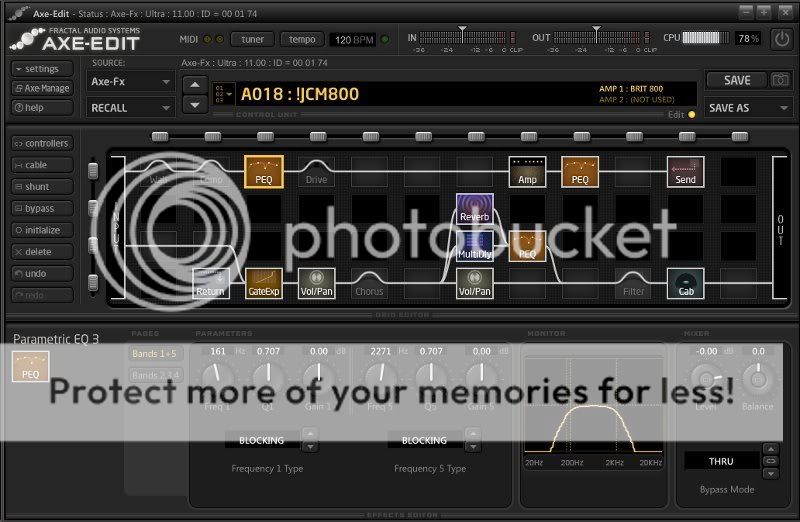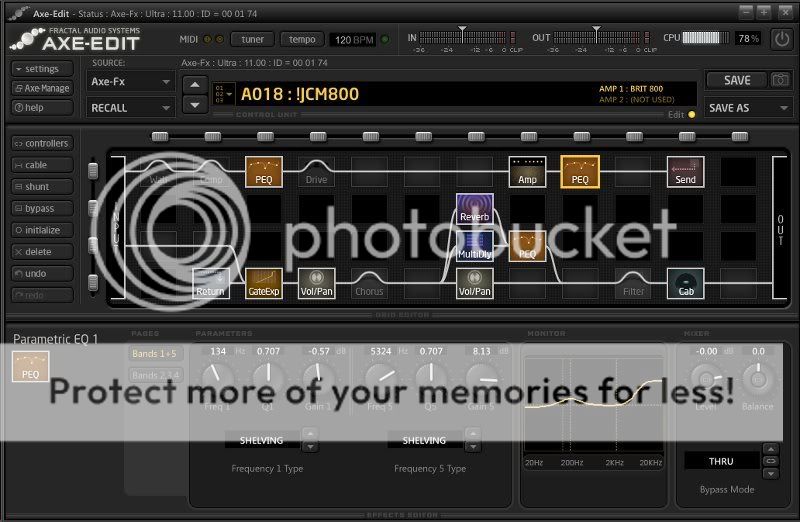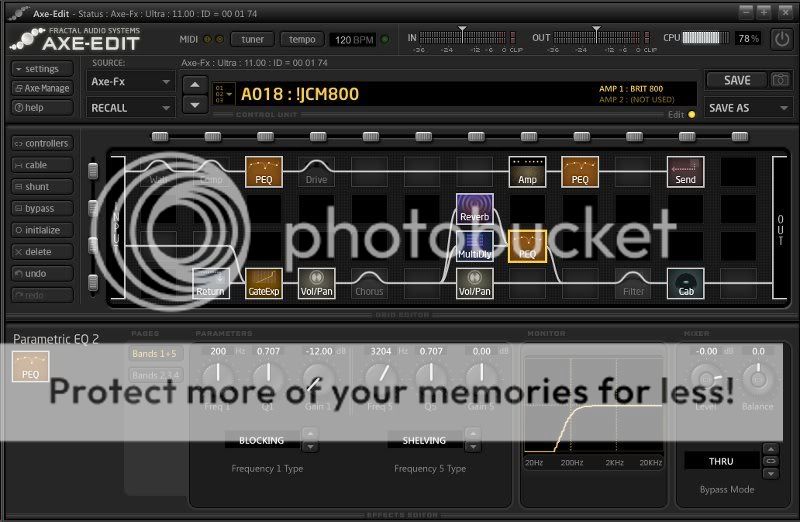This post was originally written (and longer lol) for another site whose users are not that familiar with the Axe-Fx, hence the somewhat simplistic approach. I edited to point out the aspects that I believe to be relevant to the topic of this thread.
-------------------------------------------------------
I use my Ultra for two purposes, 1) recording and jamming at home going direct to computer and primarily listening over headphones and 2) playing with my band whereby I use the power amp section of a tube amp into a 4x12 cab.
The conversion between the two modes is a single option in the Ultra that allows me to Enable/Disable Cab Emulation.
This is my standard template where by far the only thing that really changes between my standard patches is the Amp model.
Compressor:
I use this more for getting a bit of extra grit out of the amp rather than Compression.
PEQ-1:
The first somewhat interesting aspect of this setup is the use of a PEQ in front of the amp. One of the things that I personally struggled with is rounding out the highs and avoiding 'farting' on the low end. I was able to achieve this by using High Pass and Low Pass blocking in front of the amp. The frequencies set are dependent on the individual amp type and are also affected by the Cab type.
This configuration is relatively new to my setup but it has dramatically improved my tone and also my placement in the band mix as I can now increase my volume (to sit better with the drummer) and not drown out the vocals. I stand out more and also have the ability to add more clean and round bass to my tone without clashing with the bass player.
Drive:
Drive is bypassed by default and its state is controlled by the FCB1010. I favor the TS808 with a relatively low drive, volume and mix setting but this depends quite heavily on the amp type. I strive for having just enough additional drive to noticeably saturate the distortion enough for additional compression and scream during solos. I rarely use the Drive on rhythm as I like adding Compression there instead if more 'meat' is desired.
Amp:
Whole posts can be written on the various options available in the Amp block. While I have a rudimentary understanding of what each particular parameter does and its tonal effect, I do not have deep knowledge by any stretch of the imagination. I find that I am always tweaking the following as a matter of course to get the tone I am looking for given any particular Amp/Cab combination:
1. Depth - I tend to go here first before going to the standard Bass control. Coupled with Low Freq Resonance works well for me when tweaking low end.
2. Damp - this one has a very noticeable effect on overall tone and the point at which the distortion occurs. It also affects volume and therefore is difficult to be objective about since louder inevitably always sounds better to human ears.
3. Thump - most amp sims leave it off in the Axe, I like it so I always seem to be adding a bit. It does exactly what its name implies, gives a bit of "thump" and is most evident with palm muting which I do a lot (not the metal chugga chugga type though

).
PEQ-2:
The second PEQ is used to bring back some of the frequencies blocked by PEQ1. The curve here will heavily depend on the amp and cab combination and I tweak this setting when using different amp/cabs in this template but final tweak is always done when in a band situation using the power amp and 4x12 cab. While the High Shelf tends to remain the same for most amps, the 2.5dB boost at 182 Hz used in this patch varies with different amps. The JCM tends to favor the highs and this boost gives it some girth to my ears.
Gate/Expander:
As mentioned above, I prefer the Gate/Expander to the noise gate included in the input block. Seems more transparent and flexible when used with sidechaining. The sidechain signal is set direct from input (guitar). Having the Gate after the amp sounds best to me and allows me to achieve a very noise free signal that decays relatively naturally. As with any other noise gate, decay will be more abrupt than not having one in the signal chain. Some players hate them others love them, highly personal choice based on playing style and inherent noise of the overall chain.
I tweak this block for every patch too as it depends highly on the amount of drive in signal preceding it.
Vol/Pan:
Straight forward Volume block controlled by an expression pedal. I place it in front of the effects to allow the effects to bleed through and complete on volume changes.
Chorus:
I don't use it much but its nice to have available. It is initially bypassed and controlled by the FCB1010.
Reverb:
Reverb is not bypassed by default but its mix is controlled by an expression pedal (in tandem with the Delay). This allows me to mix these effects in real-time from pure dry to quite heavy wet. I prefer running Reverb and Delay in parallel to each other as well as in parallel to the dry signal. For me, it allows for a heavier mix of effects without really losing the punch of the overall sound.
I mix this signal at 100% coming out of the Reverb block and then balance its dominance using the Level setting. I balance primarily against the Delay level to achieve the sound I want.
The dry/wet mix is controlled by the value of the Input Gain setting which is the one that is controlled by the Expression pedal.
Delay:
I opt for the MultiDelay block setup similarly to the reverb whereby its mix is controlled via the Input Gain level as set by the expression pedal. Note that the same expression pedal controls the mix of both the Reverb and the Delay.
The Delay overall comparative level is set via its Level control.
Vol/Pan 2:
The second Volume block is simply there to mix the dry signal with the wet of the Reverb and Delay. Hard wired and serves no other purpose except to maintain a good overall volume regardless of the mix of the effects.
PEQ-3:
The third and final PEQ is used on the signal coming out of both the Reverb and Delay and simply does High Pass Filtering to eliminate some of the lows. It tends to remove the 'boominess' than can result otherwise. The Reverb and Delay do have built in High and Low Pass filters individually, I am lazy and opted for a single filter instead.
Filter:
The Filter block is used to add 3dB of gain to the overall chain and is toggled by a button on the FCB1010. I use it to quickly add volume for leads, such it is initially bypassed.
Cab:
I favor the Ownhammer IRs, this patch is using the Mesa V30 cabs in a stereo configuration. When recording I change to using dual cabs in Mono mode and panned as the quality of the IRs increases in Mono mode.






